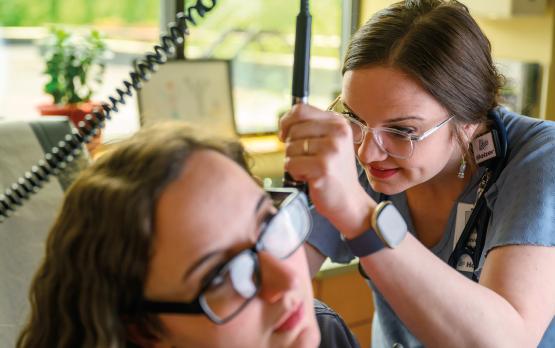
Carry me Ohio
In 2016, photo book publisher Sturm & Drang released, “Carry Me Ohio,” the first of several documentary book projects Matt Eich, BSVC ’09, has undertaken in communities across the nation. The book series, titled “The Invisible Yoke," refers to the unseen legacies—like extraction industries and racism—which still influence people in these places.
Eich tells the story behind each image, all of them drawn from “Carry Me Ohio.”
Mary Reed, BSJ ’90, MA ’93 | May 23, 2017
Share:

Disclaimer: It is not the intent of Ohio University to imply an endorsement by any service branch of the U.S. Armed Forces.
Russellville, Ohio 2012.
That’s a rally for a fallen soldier who came from that town, Russellville. The guy in the background with older vets surrounding him around the frame illustrates past and present. That’s kind of the way that a lot of these little Ohio towns feel, stuck in time. Photography has a way of accentuating that. There’s something about a photograph that’s intrinsically nostalgic because it’s automatically in the past. “The Invisible Yoke” as a title refers to an unseen burden of memory that we share collectively as a country. You may have never been to Ohio or Kentucky, but you have an idea in your head that may be based on hearsay or stereotype. It’s never that simple in these places.

Vinton County, Ohio 2008
That was one of the few remaining mining operations that I was able to get access to. The scale of it was the thing that really struck me. It was much larger than I had imagined. It’s hard to imagine land coming from that state and being repurposed or being usable again. I wanted to have at least as part of this ongoing visual documentation of the region something that at least alludes to this past. Coal mining is not the economic force that it used to be, but it’s super prevalent in the culture.

Carbondale, Ohio 2007
The picture conveys the intensity of this guy, Clayton, who’s an ex-con and is doing prison-style tattoos out in the woods. I definitely felt deeply uncomfortable on a lot of occasions. I had this paranoia that people assumed I was a cop because I wasn’t from around there and I was rolling a camera. Sometimes they’ll ask you. Sometimes they’ll drink and smoke with you and see if they think you’re okay. Boys in Glouster, Ohio, rolled by and said, ‘Hop in the car.’ For some reason, I got in the car and we rolled around and after a while they dropped me off on a main street and told people they thought I was all right. More people opened up to me after that.

Chauncey, Ohio 2006
There are definitely some symbols in this photo of white poverty. It echoes previous work made in the documentary tradition. There’s not a lot that marks the time period. It speaks clearly that this place is not an easy place to grow up. That was something that I struggled with early on – how do you photograph difficult situations in a dignified way? The people who live there don’t think about being impoverished, necessarily. It’s just their life. It’s not their main story. It’s more about community, family, resilience.

Glouster, Ohio 2007
I was compartmentalizing. ‘These are my personal pictures; these are my professional pictures.’ The common thread was me. That’s a picture of my friends emerging from Burr Oak Lake out there near Glouster. It was a few days before I got married. It has all of that feeling in a picture that I’m looking for, the balance between a technically rigorous frame and an emotional quality. The image itself is of young people emerging from the water at night in this bleary-eyed, late-night, partying kind of way. It echoes this period of time in our lives when we were on the cusp of adulthood and trying to figure out who we were. I think it’s kind of the way the kids around there feel, except that they weren’t going to college, necessarily.




